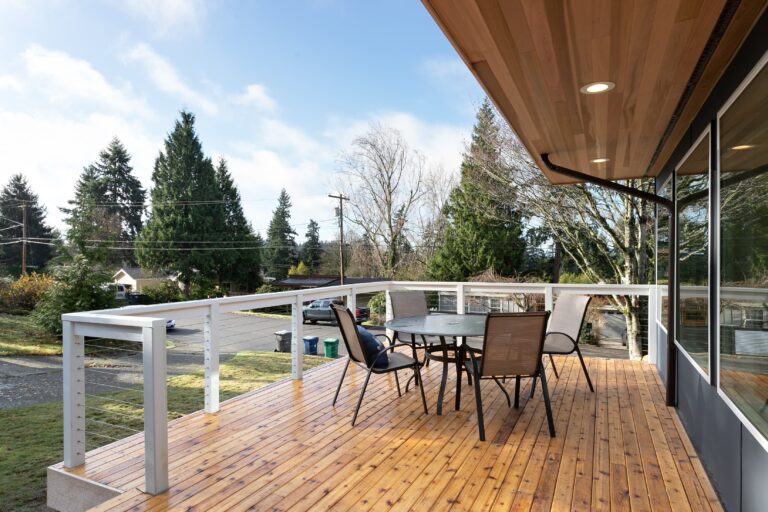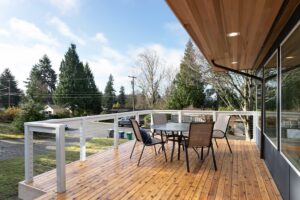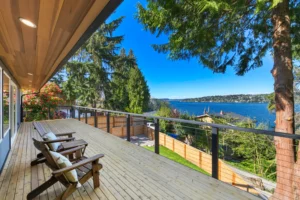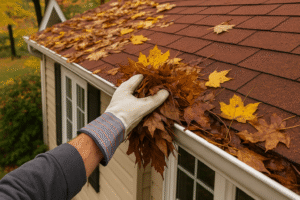Homeowners often want to know how factors like deck size, layout, and overall design impact the planning process when updating or rebuilding a deck. The short answer is that these variables directly shape the entire scope of your project — from how much material you’ll need to the structural complexity involved. Understanding these details early allows you to plan realistically, avoid unnecessary delays, and move into the design phase with clarity and confidence. And if you’re also preparing your budget, here’s a complete guide that explains what affects the cost to replace a deck.
Why Deck Size Matters in Early Planning
Material Quantities Increase as Decks Get Larger
Deck size directly affects the amount of material your project will require. As square footage increases, so does the need for framing lumber, decking boards, joists, hardware, and railings. Even small increases in dimensions can significantly raise the total number of boards, fasteners, brackets, and support posts involved. This is why accurately measuring your deck early is essential — it gives you a realistic picture of what the project will entail long before you begin choosing finishes or layouts.
Larger Decks Require More Structural Consideration
A bigger deck isn’t just “more boards” — it demands stronger structural planning. Larger footprints typically need additional joists, deeper beams, more support posts, and properly spaced footings to safely distribute weight. The wider the span, the more engineering considerations come into play. This is especially important in the Pacific Northwest, where moisture and soil conditions can impact long-term stability. Ensuring the substructure is designed correctly prevents sagging, movement, and premature repairs down the road.
How Size Impacts Timeline and Scheduling
Deck size also affects how long the project will take from start to finish. Larger decks require more time for demolition (if there’s an existing structure), site prep, framing, installing decking boards, and completing finishing elements like trims or railings. Even a one-day delay in any stage can extend the overall timeline when the footprint is substantial.

The Role of Deck Layout in Project Complexity
Simple Layouts vs. Multi-Level or Wraparound Decks
The layout of your deck heavily influences how complex the project will be. A simple rectangular or square deck is generally straightforward to build and requires fewer custom cuts, transitions, and framing adjustments. In contrast, multi-level decks, curved designs, or wraparound layouts introduce additional labor, more detailed planning, and extra structural support. Each elevation change or unique angle adds steps to the framing process and extends the timeline, making layout one of the most impactful design choices in the overall project.
Working Around Obstacles (Trees, Slopes, Existing Structures)
Your yard’s natural and built features also play a key role in how complex your deck layout becomes. Elements like mature trees, sloped terrain, retaining walls, or existing structures (such as patios or home extensions) require precise design adjustments. These obstacles may impact where footings can be placed, how the framing is configured, or whether additional engineering work is needed. Planning around real-world site conditions ensures the deck fits seamlessly into the space while maintaining structural integrity.
Traffic Flow and Usability Considerations
A well-designed deck isn’t just attractive — it supports how you use your outdoor space. The layout determines where stairs should go, how people move between different areas, and how furniture or grilling zones are arranged. A tight or awkward layout can limit usability, while a thoughtful design improves flow, maximizes seating areas, and enhances overall functionality. Considering traffic flow early helps you avoid bottlenecks, unsafe stair placements, or areas that feel too cramped for entertaining.
How Design Features Influence Project Planning
Railings, Stairs & Built-In Features
Design elements like railings, stairs, and built-in additions can significantly expand the scope of your project. Railings alone vary widely in style and complexity — from simple wood pickets to modern cable or composite systems — each requiring different installation methods and hardware. Stairs also add planning needs, especially when your yard has grade changes or multiple entry points. And if your design includes built-in features such as benches, planters, lighting, or even a small fire-pit area, you’ll need additional framing, spacing, and finish work. These enhancements elevate your deck’s usability, but they also add layers of detail that must be considered early in the planning process.
Choosing the Right Material for Your Design Vision
Your choice of decking material plays a major role in shaping both the look and long-term performance of your project. Cedar offers a warm, natural aesthetic and blends beautifully with Pacific Northwest homes, while composite materials provide low-maintenance durability and a wide range of color options. PVC decking, on the other hand, excels in moisture resistance and long-term fade protection. Each material influences your design possibilities — and the amount of upkeep you can expect over time.
You can explore more material options through our dedicated pages:
These resources help homeowners compare aesthetics and maintenance needs more effectively before choosing a design direction.
And if your design planning is moving toward a full rebuild, you may want to work directly with a deck replacement contractor who can guide material decisions and structural needs.
Deck Shape, Patterns & Architectural Style
The shape of your deck and the patterns you choose for your decking boards also influence complexity. Simple board layouts are straightforward, but design-forward concepts — like picture-frame borders, diagonal patterns, or decorative inlays — require extra precision and more time during installation. These choices can elevate your deck’s visual impact and integrate beautifully with your home’s architectural style, but they also add planning steps related to framing, spacing, and board waste calculations.
If you’re thinking ahead about how these design elements might shape your overall rebuild, you can review the full breakdown of what affects the cost to replace a deck
How to Prepare for Your Deck Rebuild
Measure Your Existing Deck
A simple first step in planning a deck rebuild is measuring your current structure. Begin by sketching the layout on paper and measuring the length and width of each section. Multiply those dimensions to calculate square footage, and note any angled areas or bump-outs separately. Even a rough measurement helps you understand the overall footprint, which is essential for determining materials, planning your layout, and estimating the scope of the rebuild.
Identify Which Areas Need Structural Updates
Before moving into design decisions, assess your deck’s condition carefully. Look for soft spots in the boards, signs of rot in joists or beams, loose railings, shifting posts, or inadequate footings. Moisture-heavy areas like the Pacific Northwest often accelerate wear on older structures, so early detection is key. Identifying these issues ahead of time helps you understand whether your project is simply resurfacing—or whether deeper structural updates are needed to keep your outdoor space safe and long-lasting.
When to Call a Professional to Evaluate Your Design
If you’re unsure about structural integrity, layout adjustments, or material compatibility, calling a professional is the safest next step. A qualified expert can evaluate load-bearing components, recommend the right materials for your environment, and make sure your design meets Washington’s building codes. Their input also helps prevent future issues like uneven settling, water intrusion, or spacing errors. For full rebuilds or complex layouts, working with an experienced deck replacement contractor is the best way to ensure your vision is executed safely and efficiently.
When Your Project Might Require a Full Replacement
Not every deck can be improved through repairs or surface updates—sometimes a full replacement is the safest and most practical option. You may need a complete rebuild if the framing has widespread rot, if the posts or footings have shifted, or if the deck no longer meets updated building codes. Major design changes, such as adding a second level, expanding the footprint, or replacing structural components, can also move your project beyond repair-level work.
If your project is leaning toward a full rebuild, here’s everything you need to know about planning for deck replacement cost in Washington
Final Thoughts
Understanding how deck size, layout, and design influence your project planning makes every step—from material selection to scheduling—more predictable and less stressful. When you take time to evaluate your existing structure, consider your long-term goals, and understand the scope of work ahead, you set your project up for a smoother timeline and better results.
If you’re starting to map out your rebuild and want to understand what goes into budgeting, here’s your full guide to what affects the cost to replace a deck
Frecuently Asked Questions

What’s the average cost to replace a deck?
In Washington, most homeowners spend between $7,000 and $30,000 for a full deck replacement. Smaller projects start around $3,000, while large custom builds with premium materials can exceed $40,000.
How much is deck replacement per square foot in Washington?
Expect to pay $30–$60 per square foot installed, depending on materials, framing, and design complexity. Labor costs are generally higher in the Puget Sound area due to local permitting and terrain challenges.
Is composite or PVC cheaper long term?
Yes — while composite and PVC decks cost more upfront than wood, they require little to no maintenance and can last 30–50 years. That means fewer repairs, no staining or sealing, and better overall ROI.
Can I reuse my existing frame? How do I know if it’s safe?
You can reuse your frame if it’s structurally sound, free of rot, and meets current building codes. A licensed deck contractor will inspect joists, beams, and posts before confirming whether the frame can safely support new boards.
Do I need a permit to replace my deck?
In most Washington cities, yes. Any structural work, framing changes, or deck expansions typically require a building permit and inspection. Your contractor should handle this process and include fees in your estimate.
How long does a deck replacement take?
A standard deck replacement takes one to two weeks, depending on size and weather. Demolition and framing usually take 3–4 days, with decking, railing, and finishing work taking another 4–7 days.
What adds the most cost — railing, stairs, or lighting?
All three can increase project costs, but custom railings and multi-level stairs typically have the biggest impact. Integrated lighting, pergolas, and seating upgrades also raise labor time and complexity.


